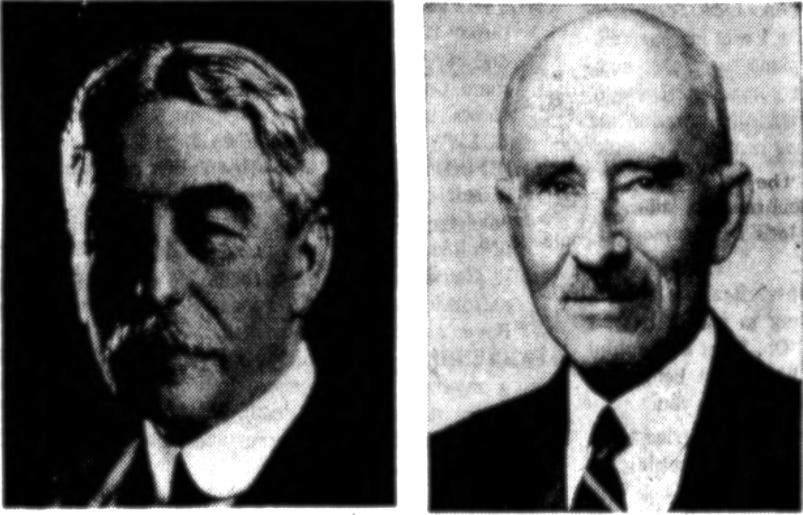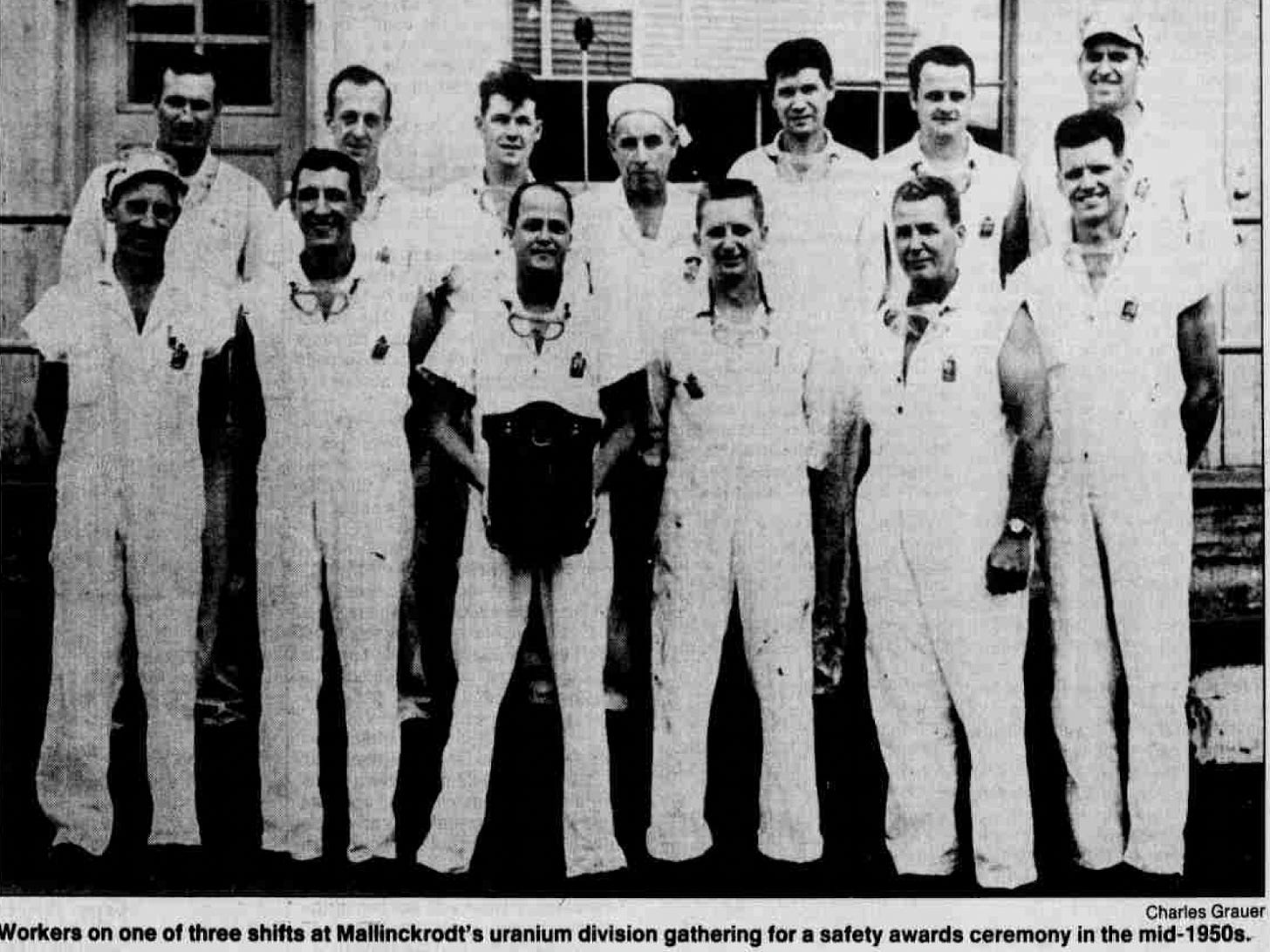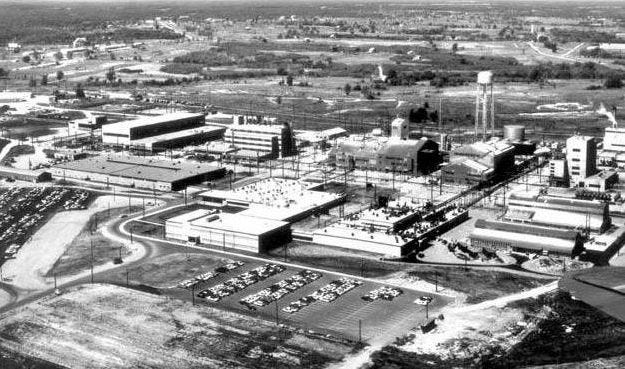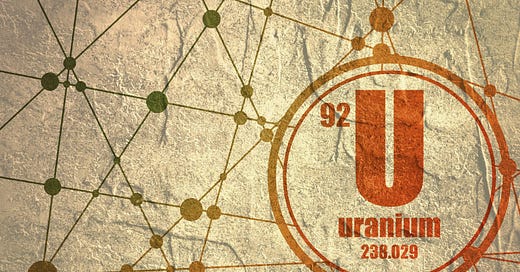Welcome to another edition of Unseen St. Louis. In this article, the first in a series, I explore the role a St. Louis company played in the Manhattan Project during World War II. Believe it or not, although the war has been over for nearly 80 years, the nuclear waste from the uranium and other radioactive substances still poses a threat to St. Louisans today.
The ‘Manhattan Project’ was the code name for the research into nuclear weapons that began in the 1940s and culminated in the United States dropping two atomic bombs on Japan, ending World War II. Nearly all of the uranium that went into those bombs was refined in St. Louis for use by the Manhattan Project scientists.
The Manhattan Project’s urgent need for pure uranium
At the end of 1941, the US had just entered World War II. Arthur Holly Compton, director of the Metallurgical Laboratory of the Manhattan Project, was overseeing the secret project to develop atomic weapons. One of his researchers approached Compton, cupping his hands as if holding an orange. He told Compton, “All I need is a lump of uranium as big as this, but I need it now.”
In order to progress in their experiments, the scientists needed highly purified uranium. The problem was that there was almost no uranium metal available. Westinghouse Electric had made a few grams on an experimental basis, and the Metal Hydrides Co. had made a few pounds of impure pyrophoric powder, but neither would suffice for the needs of the project.
Scientists had discovered that black uranium oxide could be turned into a purified uranium, uranyl nitrate, using ether, but no one had figured out how to produce it at the scale the Manhattan Project required. They needed to partner with private industry to find a way to refine uranium at the scale necessary.
Enter Mallinckrodt Chemical Works
On April 17, 1942, Compton approached Edward J. Mallinckrodt Jr. and asked if his company could purify uranium in large amounts for the atomic bomb.

Mallinckrodt Chemical Works, located in St. Louis on Broadway between Destrehan and Angelrodt streets near the Mississippi River, had been founded by three Mallinckrodt brothers in 1867. Up until the 1940s, the company was known primarily for pharmaceuticals. According to the company website, the company was the only chemical company west of Philadelphia, and it supplied local pharmacists with medications including morphine and codeine, as well as producing photography chemicals, anhydrous ammonia (for the refrigeration industry), and barium sulfate (used in x-rays).
As the story goes, Edward Mallinckrodt Jr. agreed to use his company to produce this high-grade refined uranium, and then immediately rushed back to the office. He announced to his employees that the company had joined “a secret project of great importance to the war effort,” which was called “Uranium Oxide S.L. 42-17”. That very day, started making plans with his engineers, sketching out plans everywhere, even on the walls.
Harold E. Thayer, who would later go on to lead Mallinckrodt, explained that “people worked all day and night, ‘in alleyways and corners of laboratories,” trying to figure out how to safely process uranium.
And it worked. Within just three months the company had figured it out and was already producing a ton of refined uranium every day.
Difficult and dangerous work
To meet the needs of the Manhattan Project, the company reassigned every employee who could contribute in some way to working on the project. These employees worked 14-hour days and seven-day weeks, in some cases without a single day off until 1945, because of the urgency and demand for uranium for the war effort.
The uranium they handled was a highly-concentrated ore called pitchblende that came from the Belgian Congo and contained far more uranium than that mined in the US.
In simple terms, the purification process involved mixing the uranium with nitric acid and then heating the solution in giant steel kettles repurposed from a plant in Jersey City. Then the workers had to combine a 300-gallon pot of molten uranium nitrate with cold ether in a container cooled by ice water to prevent explosions. This process would ultimately produce uranium dioxide powder. Later, the company also produced ‘green salt’ (uranium tetrafluoride) and uranium metal.
Because the process was so secret, Mallinckrodt employees could not discuss what they did outside of work. At one point the federal government asked the company to change the name of the project to “Tube Alloy Dioxide” to further obfuscate their task. Either way, few workers had any clue as to what they were actually doing. One employee heard the term “radioactive” and thought their work had to do with radios.
In fact, the workers who handled the uranium processing only found out what they had been working on after the bombs were dropped on Hiroshima in August 1945.
Protecting the workers
About 3000 workers were involved in uranium processing at Mallinckrodt from 1942 to 1966.
In 1947, former Marine Mont Mason was put in charge of worker safety. Despite the dangerous nature of their work, Mason found it difficult to convince his colleagues to take safety precautions seriously. Even after they found out the nature of their work, and were told to wear respirators and get tested at a local hospital, most of the Mallinckrodt workers didn’t understand why, and compliance was sometimes difficult to achieve. After all, the whole concept of radioactivity was new and largely unknown to the public.
As one former employee told the Post-Dispatch in 1989,
“a lot of us didn’t understand what they were talking about. Half of the men slept through the lectures. They tried to tell them, but you know how people are. Some of them won’t listen.”

Even well after the war, workers continued to work with radioactive materials without sufficient precautions, likely because the equipment could be hot and cumbersome to use. As the Post-Dispatch noted in September 2020, employees
“cleaned or repaired equipment without shields, breathed contaminated dust and were exposed to hundreds of times the radiation considered safe even at the time.”
Ultimately, many workers were exposed to radioactivity from uranium dust that was 200 times more than would be allowed today. Some were also exposed to even more toxic thorium and other radioactive materials.
But despite later health concerns (many of the workers developed cancer or leukemia that may have been a result of their jobs), many of the workers remained proud of their efforts decades later. As Fred Aikainen told the Post-Dispatch, their work was “a necessary evil,” helping to shorten the war. He pointed out that “it kept us out of war, where millions of guys like me would’ve died with a hole in them.”
The dirty one
After seven years of uranium refining, Mallinckrodt closed the original processing plant, Building 51, in 1948 due to unsafe levels of radiation. Before the closure, C. L. Karl, the St. Louis manager for the US Atomic Energy Commission, addressed the state of uranium processing in the city. “Most of the facilities erected at the Mallinckrodt plant during the war were of a semi-permanent nature,” he said, “and were constructed on an emergency basis.” At that time he announced a $2.5 million project to modernize the company’s facilities so that Mallinckrodt could continue to do the work on a permanent basis.

Mallinckrodt moved the equipment to a new building and continued making refined uranium, but this time for private research and commercial use, and not at the extreme purity required for atomic weapons. One of their contracts was with Dow Metal Products, a division of Dow Chemical Co. Mallinckrodt worked on straightening uranium rods at Dow's plant in Madison, Ill. At least as of 2000, the destination and purpose of the rods remained a secret.
In 1957 the Atomic Energy Commission—the agency that took over nuclear projects after the war—opened a new factory that would be operated by Mallinckrodt at Weldon Spring, just west of St. Louis in St. Charles County. This led to Mallinckrodt closing their uranium plant on Destrehan, laying off 180 workers. This plant operated until 1966.

Site cleanup and radioactive waste
The US government paid for cleanups at the downtown St. Louis Mallinckrodt complex immediately after Mallinckrodt moved the uranium processing to a new facility at this complex (1948-1950), and then again when the company moved to Weldon Spring, 1957-62.
Over the years, much of the radioactive and other waste material was taken to a 21.7-acre site adjacent to Lambert Field (which had been acquired by the city via eminent domain in 1946) and dumped there. This site is now known as SLAPS (St. Louis Airport Site).

In 1962 the US Atomic Energy Commission put almost 117 tons of material stored at the airport site up for sale. It was purchased by the Continental Milling and Mining Co, which hoped to extract additional minerals. It was trucked to a secondary location on Latty Ave. and stored there before being shipped to Colorado. (The remaining material was later illegally dumped at the West Lake Landfill in Bridgeton.) Both the airport and Latty sites were adjacent to Coldwater Creek, a waterway that runs through many North St. Louis county neighborhoods. Over the years, some of the material leached into the creek and was carried downstream.
In 1966 a paper entitled “Survey of Sources of Ionium (Thorium-230) listed the St. Louis Airport site as the richest source of Thorium in the US, exceeding what was available at uranium mines.
Additionally, in the 1960s at least 5,000 truckloads of contaminated rubble from the Mallinckrodt complex in the city were dumped in a quarry near the Weldon Spring site.
Although the St. Louis city site went through two cleanups between 1948 and 1962, there was still considerable contamination. The Post-Dispatch reported in 1989 that, according to records only discovered in the 1980s, Mallinckrodt also dumped 233,000 pounds of ore in 30-gallon steel drums on their downtown property in 1972 and 1973 and then built a warehouse over it with a 10-inch thick concrete floor. Just a few years ago, in 2019 St. Louis Public Radio reported that most of the cleanup of this site had been completed.
(Both the Weldon Spring site and the SLAPS/West Lake Landfill/Coldwater Creek stories will addressed in upcoming posts here on Unseen St. Louis.)
The end of a chapter
Mallinckrodt’s involvement with uranium processing ended with the closure of the plant at Weldon Spring in the 1960s.
But there’s no doubt that being involved with the Manhattan Project changed the company’s fate. Although most people were familiar with Monsanto, as its competitor, Mallinckrodt wasn’t very well known before the 1940s. As Mallinckrodt VP and General Manager Charles Swartout said in 1967, the company’s involvement with the war effort “resulted in a drive and competitive spirit within the company suddenly realizing that it was up with the big boys now.”
Mallinckrodt today
Although the company is not involved with nuclear weapons any longer, and they have returned to their roots, producing pharmaceuticals. The company is now based in Ireland for tax purposes, but it still maintains several locations in the St. Louis area (including the downtown complex) as well as elsewhere in the US. It produces, among other things, acetaminophen, hydrocodone, oxycodone, and dextroamphetamine sulfate. But all is not rosy for the company these days. In 2020 they made a $1.6 billion settlement to several states for their role in the opioid crisis. More recently the company settled a federal lawsuit alleging underpayments of Medicaid drug rebates and is expected to emerge from Chapter 11 bankruptcy this year.
Thanks for reading this first installment in the radioactive history of St. Louis. I hope you found it interesting!
In future articles, I’ll be examining what happened to the radioactive waste in more detail, including what the EPA has (and has not) done over the years, what happened at the second uranium processing plant out in Weldon Spring, and the ongoing battles to clean up the waste that many believe has made many people sick throughout north St. Louis County.
Subscribe so you won’t miss any of the upcoming installments, and be sure to leave a comment!
Sources
How a Midwestern Potato Farm Became the World’s First Nuclear Waste Site (Atlas Obscura)
Atomic Homefront (HBO documentary)
The First Secret City documentary and timeline
The Safe Side of the Fence documentary
Mallinckrodt: Our Story (Mallinckrodt.com)
Mallinckrodt’s Uranium Division News June 1962
Mallinckrodt Agrees to Pay $260 Million to Settle Lawsuits Alleging Underpayments of Medicaid Drug Rebates and Payment of Illegal Kickbacks (US Justice Dept.)
Mallinckrodt Plan of Reorganization Confirmed by U.S. Court (US Justice Dept.)
St Louis Post-Dispatch
15 August 1945
17 Sept 1948
7 December 1949
14 June 1958
2 July 1967
6 February 1994
7-part series “Legacy of the Bomb: St. Louis’ Nuclear Waste” (12 Feb-19 Feb 1989)
30 April 2000
20 September 2000
19 December 2021
Mallinckrodt (Wikipedia)
Cleanup Of Manhattan Project Site In Downtown St. Louis Nears Completion (St. Louis Public Radio)
The Mallinckrodt Chemical Works Story, 1962 (Atomic Heritage Foundation)
Mallinckrodt Chemical Works (Just Moms STL)







This article is terrific. My son works at these clean up sites. This totally explains the history and the geography. Thanks! I can’t wait for him to read this
While working at RCGA, met Dr. Ardath Emmons, who was with MU and had been involved in nuclear development at Oak Ridge. At the time, he was consulting on the Callaway Nuclear Energy project. He had such interesting stories to share. Wish he was still alive. He was an extremely intelligent and kind individual.